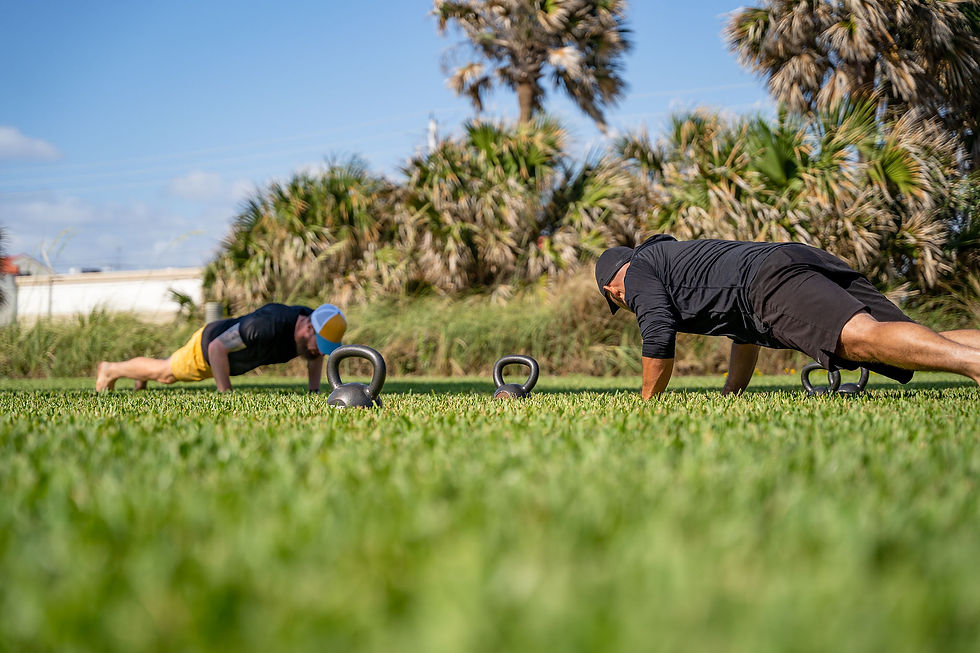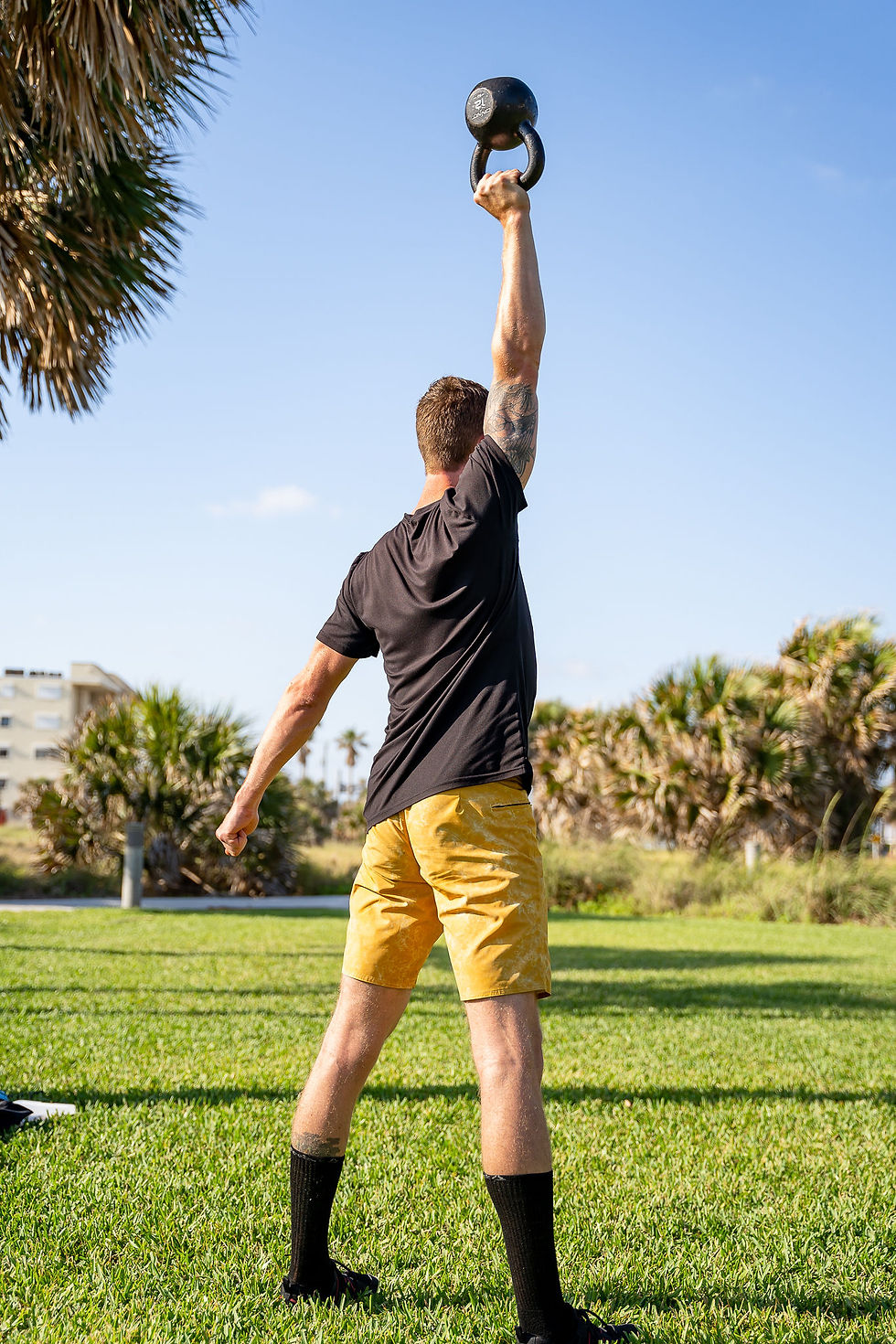Active but Still Stuck? Discover Why Real Exercise is the Missing Link
- Jason VanSickle

- Sep 13, 2024
- 11 min read
Are you an active person who is feeling stuck and can’t figure out why you can’t shed those extra pounds you’re carrying around? Do you have aches and pains from all of the day’s activities? Out of breath doing things that a few years ago you could do with energy and vigor?
I’ve heard from experienced exercisers as well as those who don’t regularly exercise that they think certain activities qualify as exercise, but this is false. Not all physical activity is exercise and you need regular exercise to develop the adaptations that will free you from your frustrations and help you develop your health and fitness.
It’s quite common to confuse physical activity with exercise. Working up a sweat doesn’t necessarily mean that you have exercised. Feeling tired after speed walking on your way to an appointment unfortunately doesn’t qualify as exercise. Recreational activities and sports are physical activities that can be the most challenging to classify as exercise or not.
What is Exercise?
Exercise is a form of physical activity that is planned, structured, repetitive, and performed with the goal of improving health or fitness. Although all exercise is physical activity, not all physical activity is exercise. (Physical Activity Guidelines for Americans 2nd edition 2018)
There are a few things we can take away from this definition of exercise that I want to highlight.
All exercise is physical activity, but not all physical activity is exercise.
Physical activity refers to any bodily movement produced by the contraction of skeletal muscle that increases energy expenditure above a basal level. (Physical Activity Guidelines for Americans 2nd edition 2018)
Adaptations improving health and fitness are the result of the planning, structure, and the repetitions that make exercise exercise. You can achieve adaptations from physical activity, but that isn’t why the physical activities are done. The organization of exercise is what makes achieving adaptations part of the science of exercise. This includes the periods of inactivity, or rest periods as well as repeating the activity over time. The adaptations from exercise do not happen overnight and will need to be repeated over the course of weeks to months.
One of the first things I do when I coach someone is calculate their Total Daily Energy Expenditure, which has four different components, two relating to how physically active you are.
Physical activity is divided into two categories:
Exercise factors or Exercise Activity Thermogenesis
Exercise Activity Thermogenesis (EAT) is the energy burned specifically during exercise.
Lifestyle factors or Non Exercise Activity Thermogenesis
Non Exercise Activity Thermogenesis (NEAT) is the energy burned during physical activities that do not qualify as exercise such as walking during work, standing in a line, fidgeting, carrying groceries, or folding clothes.
False Beliefs
It’s a common misconception that labor and physical tasks count as exercise.
The science of human action, praxeology, distinguishes between different forms of human action and looks at goals (ends) and the actions (means) we take to achieve those ends. Human beings are special because we act intentionally, not just reflexively or involuntarily. Human willpower is a special thing and with it we can develop our body’s using exercise. There are physical activities we do everyday that are obviously not exercise and some that closely resemble the actions or movements that we do in a workout.
The purpose of labor is to achieve the ends of producing goods and services or the physical work to support yourself or others. Exercise is an intentional act (means) to achieve certain specific bodily adaptations (ends).
Exercise Benefits
There are many different benefits and adaptations from exercising. Exercise provides the body the stimulus for physical, mental, and performance improvements.

You can apply resistance exercises for strength, endurance, power, and body composition. Cardio-respiratory exercise for health, performance, and longevity. Flexibility, mobility, and balance training for the nervous system, joint health, and improved proprioception which is the cumulative sensory input to the central nervous system from all mechanoreceptors that sense body position and limb movements (National Academy of Sports Medicine)
Exercise also can have mental health benefits. It makes you more resilient, increasing your body’s capacity to deal with stress, can lead to better moods due to the chemical cascade that floods the body with exercise, and provides mental clarity due to the intention of focus that is inherent in exercise.
The adaptations from exercise, can also alter your ability to perform in sports and daily life.
Let’s dive into more of the specific adaptations and how we use exercise to achieve them.
Mind-muscle connection
The mind-muscle connection is the integration of the nervous system and your musculoskeletal system. The connection is descriptive of the brain sending a signal to the muscles to activate the muscles and use them more efficiently. Your brain sends nerve signals to the motor units that control the function of skeletal muscles. When we exercise, we are intentionally forging connections that increase coordination and muscle efficiency through motor learning which is the integration of motor control processes. This practice and experience leads to relatively permanent changes in the body’s capacity to produce skilled movements. This process is known as motor development which is the change in motor skill behavior over time throughout the lifespan.
Motor learning will affect posture, metabolic health, and body composition changes.
Mind body fitness is a specialty of Wellness Moves. Book a consultation to evaluate how we can help you forge a strong mind-body connection.

Posture
Posture is the alignment that you find your body in during activity. Good posture could be described as the body’s tendency and ability to achieve and maintain neutral position which means to have normal length tension relationships between the muscles of the body. “If a muscle is too short, it is weakened. If a muscle is too long, it is weakened. A muscle at optimal length can produce optimal strength. (NASM)” Poor posture alters the length tension relationships of the muscles, leading to movement deficiencies, and poor functioning of the musculoskeletal system.
Metabolism
Your metabolism refers to the processes of the body responsible for energy production. Exercise is highly energy intensive. The mitochondria are responsible for energy production in the muscles and you can train your muscles to have more mitochondria. Training mitochondrial density in the muscles correlates to your body’s work capacity. Your metabolism is also dependent on many chemical reactions in the body that rely on the hypothalamus, pituitary, thyroid, adrenal axis. Metabolic stress is needed for improvements in body composition.
Body Composition
There are many different ways that exercise can change your body composition. The most common body composition changes that people exercise to achieve are losing weight, changing their body fat percentage, and increasing lean muscle. What are some of the different body composition metrics commonly seen?
Weight: Your total body mass
BMI: Your weight in kilograms divided by the square of your height in meters. Not the greatest metric for health. BMI does correlate to health outcomes, but it is an incomplete metric as people with a high amount of muscle mass can and low body fat have the same BMI as someone with low muscle mass and high body fat.
Body Fat: Your total amount of body fat. Healthy body fat for men and women varies. Women should have more body fat on them than men.
Fat Free Body Weight: Total weight of the body minus any measured fat. This includes the weight of organs, muscle, bone, connective tissues, and water.
Subcutaneous Fat: The fat on your body that is visible. You need some subcutaneous fat as it does have multiple purposes.
Visceral Fat: The fat found around your organs. Having excess visceral fat is associated with serious medical issues. Inflammatory fat that can narrow your blood vessels and increase blood pressure.
Skeletal Muscle and Muscle Mass: Total percentage of skeletal muscle weight in your body and percentage of muscle. Skeletal muscle is what you are growing and developing while exercising. More muscle in the body means you are burning more calories throughout the day and will help in losing body fat. Muscles are stores of amino acids, water, and glycogen in the body.
Bone Mass and Bone Mineral Density: The total mass of your skeleton. “Individuals who exercise regularly generally achieve greater peak bone mass than those who do not.” (NASM) Bone mineral density is a very important metric because having higher bone mineral density is important for preventing breaks as we age. Bone mineral density is an indirect indicator of osteoporosis and fracture risk (NASM).
Schedule a call if you would like to have a consultation regarding your body composition and come up with a road map to achieve the body that you desire.
What’s the difference?
What’s the difference between some seemingly similar things and what qualifies one as exercise and the other not?
Carrying Groceries vs. Carrying Weights
Both involve carrying something. Carrying groceries and a farmer's carry will even be the exact same movement pattern. When you are carrying groceries, the end isn't to achieve a specific adaptation. You are carrying groceries because you purchased groceries and you need to bring them inside and put them away.
You could modify this to make it more exercise-like. You could organize your carrying into sets and use rest intervals to achieve an adaptation, but more than likely the stimulus is not consistent or great enough to elicit an adaptation.
When you do a carry at the gym, you are performing to achieve some sort of adaptation. I classify carries as a heavy walk. Walking is the second most basic movement pattern that I teach and carries are a great way to integrate your muscles to increase your strength and endurance.
One way you could distinguish between the physical activity of carrying groceries and exercising carrying weights is that with the weights, you can determine the volume fairly easy. Measuring your volume is a component of exercise that highlights the structural component of exercise.
Gardening vs. Strength Training:
Gardening is labor and can even be performed to improve health. I think gardening is a great activity, but is laborious and not exercise. It is an activity that is going to be difficult to organize in a way that provides a stimulus for adaptation. It could be organized and structured for adaptations, but you’re not doing that. You’re not organizing your gardening into sets and reps, with specific rest times. It’s better to think of gardening as contributing to your physical activity for the day rather than as exercise.
Strength training is a well developed science. Strength training is organized into exercises we can do for movement patterns and muscle groups to develop our musculoskeletal system. Periodization, sets, reps, tempo, rest intervals, and intensity are all taken into consideration when developing a strength training program. It is a very organized endeavor to achieve strength adaptations.
Walking, Sports, and Cardio-respiratory Training
Walking is perhaps the most difficult activity to distinguish. Your step count is highly correlated with overall health. I believe it is both a normal everyday physical activity and can also be called exercise. However, there are cases when walking is not exercise and times when it qualifies. It comes down to means and ends. If you are walking intentionally for the benefits of walking, let's say for 10-15 minutes after a meal, or to jumpstart your day or unwind after a long day, I would classify this as gentle exercise. Even walking your dog I would classify as exercise. Walking as a means of transporting yourself would fall under your physical activity for the day.
Sports are another activity that is tough to distinguish as physical activity or exercise. Sports meet a lot of the requirements for our definition of exercise, but still are not exercise. Again, we must look at means and ends. Are you doing the activity to develop a skill or to compete, or are you doing it to acquire a desired adaptation. A fun example to look at that really blurs the line is boxing or kickboxing for cardio. I personally love to kick the bag as a cardio workout. The way in which I kick the bag is exercise. My primary motivation is to develop my body’s energy systems, power, and cardio-respiratory fitness. I have no plans of ever competing in a striking martial. I am doing it for cardio-respiratory, power, and energy system development.
Cardio-respiratory training is another well developed science. Cardio-respiratory adaptations are one of the most important metrics in both health and fitness. Resting heart rate, heart rate variability, VO2 max, blood oxygen level testing to measure breathing efficiency, and blood pressure are all metrics we can target to improve with exercise.
There are many modalities for cardio-respiratory training and something such as running a marathon may seem like exercise, but it is a sporting event. This is a test of your running ability, endurance, and mental toughness within the framework of a sport, not necessarily an exercise meant to promote a specific physiological adaptation. While running a marathon or requires incredible physical fitness and conditioning, the act of participating in the event is a competition and not structured exercise. It’s the structured, intentional training behind the scenes that constitutes exercise, whereas the game, match, or race is the event in which those adaptations are put to use.
If cardio-respiratory fitness or conditioning for an event is something you need help with, I am a Bioforce Certified Conditioning Coach. Schedule a call if you want to compete at your best.
Debunking Exercise Myths
Muscle soreness
Just because you are sore doesn’t mean you exercised. Muscle soreness is something that happens with exercise and Delayed Onset Muscle Soreness or DOMS is a common term in the fitness industry. Muscle soreness is not a metric of the effectiveness or quality of a workout. In fact, it could mean that you did too much and reached the exhaustion phase of General Adaptation Syndrome.
Harder or more is better
Overtraining and under-recovering are real problems in the fitness world. Just because something is hard, does not mean it is exercise and more is not better, more is just more. You can exert yourself and do strenuous activities, but this does not mean that it's exercising. You can be a masochist and do hard or hurtful things for the sake of beating yourself up. The end goal of improving one's health and fitness is the hallmark of exercise. There is a sweet spot for fitness adaptations. As Yuri Verkhoshansky, the father of plyometrics, famously said: “Any idiot can make another idiot tired.” Real exercise aims to improve your health and fitness, not simply leave you worn out.
Sweating
You can sweat without exerting much physical effort. Just because an activity makes you sweat, does not mean you are exercising. You also do not need to be sweating to be achieving an adaptation.
Resting
Your rest periods are one of the most important parts of exercise. Different types of training have different rest periods. Some people never achieve certain adaptations because they do not take their rest periods seriously. “…the rest pause is the most important regulator of the training effect, and one must use it very skillfully.” Yuri Verkohoshansky
Exercise Recommendations
The recommendations for exercise are dependent on goals. Different goals will have different recommendations based on the adaptations that are desired. We must also take into account meeting you where you are at. Someone who is on the sick side of the wellness spectrum will have different recommendations that someone who is trying to achieve peak performance.
Below is a table of general recommendations for the promotion of health and prevention of chronic disease in older adults.

As you can see, exercise is a well developed science with specific adaptations that we can achieve with the organization and application of exercises.
I challenge you to rethink how you think of exercise. When done right, exercise can produce adaptations in the body that are more profound than any drug. Your body is capable of so much and effectively applying exercise science can transform your body and the trajectory of your life. You just will not get the same adaptations that your body can achieve through performing labor. Exercise and movement is medicine and we must manage this medicine in order to gain the benefits.
Experience the difference between physical activity and exercise with Wellness Moves. Schedule a call today to get your personalized exercise program and start your transformation to discover strength, vitality, and confidence!






Comments